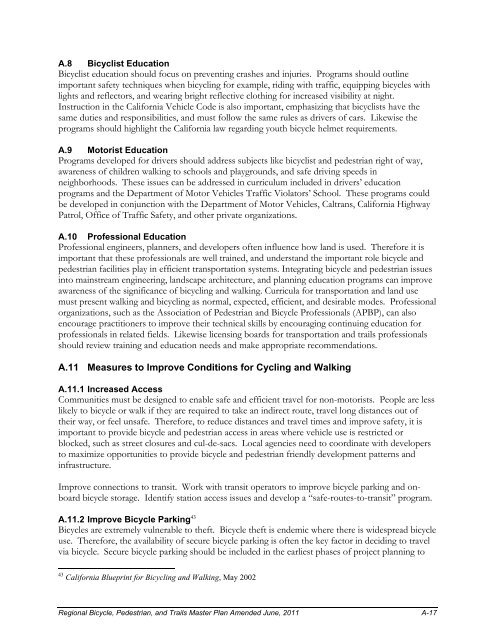Bicycle and Pedestrian Master Plan - sacog
Bicycle and Pedestrian Master Plan - sacog
Bicycle and Pedestrian Master Plan - sacog
Create successful ePaper yourself
Turn your PDF publications into a flip-book with our unique Google optimized e-Paper software.
A.8 Bicyclist Education<br />
Bicyclist education should focus on preventing crashes <strong>and</strong> injuries. Programs should outline<br />
important safety techniques when bicycling for example, riding with traffic, equipping bicycles with<br />
lights <strong>and</strong> reflectors, <strong>and</strong> wearing bright reflective clothing for increased visibility at night.<br />
Instruction in the California Vehicle Code is also important, emphasizing that bicyclists have the<br />
same duties <strong>and</strong> responsibilities, <strong>and</strong> must follow the same rules as drivers of cars. Likewise the<br />
programs should highlight the California law regarding youth bicycle helmet requirements.<br />
A.9 Motorist Education<br />
Programs developed for drivers should address subjects like bicyclist <strong>and</strong> pedestrian right of way,<br />
awareness of children walking to schools <strong>and</strong> playgrounds, <strong>and</strong> safe driving speeds in<br />
neighborhoods. These issues can be addressed in curriculum included in drivers’ education<br />
programs <strong>and</strong> the Department of Motor Vehicles Traffic Violators’ School. These programs could<br />
be developed in conjunction with the Department of Motor Vehicles, Caltrans, California Highway<br />
Patrol, Office of Traffic Safety, <strong>and</strong> other private organizations.<br />
A.10 Professional Education<br />
Professional engineers, planners, <strong>and</strong> developers often influence how l<strong>and</strong> is used. Therefore it is<br />
important that these professionals are well trained, <strong>and</strong> underst<strong>and</strong> the important role bicycle <strong>and</strong><br />
pedestrian facilities play in efficient transportation systems. Integrating bicycle <strong>and</strong> pedestrian issues<br />
into mainstream engineering, l<strong>and</strong>scape architecture, <strong>and</strong> planning education programs can improve<br />
awareness of the significance of bicycling <strong>and</strong> walking. Curricula for transportation <strong>and</strong> l<strong>and</strong> use<br />
must present walking <strong>and</strong> bicycling as normal, expected, efficient, <strong>and</strong> desirable modes. Professional<br />
organizations, such as the Association of <strong>Pedestrian</strong> <strong>and</strong> <strong>Bicycle</strong> Professionals (APBP), can also<br />
encourage practitioners to improve their technical skills by encouraging continuing education for<br />
professionals in related fields. Likewise licensing boards for transportation <strong>and</strong> trails professionals<br />
should review training <strong>and</strong> education needs <strong>and</strong> make appropriate recommendations.<br />
A.11 Measures to Improve Conditions for Cycling <strong>and</strong> Walking<br />
A.11.1 Increased Access<br />
Communities must be designed to enable safe <strong>and</strong> efficient travel for non-motorists. People are less<br />
likely to bicycle or walk if they are required to take an indirect route, travel long distances out of<br />
their way, or feel unsafe. Therefore, to reduce distances <strong>and</strong> travel times <strong>and</strong> improve safety, it is<br />
important to provide bicycle <strong>and</strong> pedestrian access in areas where vehicle use is restricted or<br />
blocked, such as street closures <strong>and</strong> cul-de-sacs. Local agencies need to coordinate with developers<br />
to maximize opportunities to provide bicycle <strong>and</strong> pedestrian friendly development patterns <strong>and</strong><br />
infrastructure.<br />
Improve connections to transit. Work with transit operators to improve bicycle parking <strong>and</strong> onboard<br />
bicycle storage. Identify station access issues <strong>and</strong> develop a “safe-routes-to-transit” program.<br />
A.11.2 Improve <strong>Bicycle</strong> Parking 43<br />
<strong>Bicycle</strong>s are extremely vulnerable to theft. <strong>Bicycle</strong> theft is endemic where there is widespread bicycle<br />
use. Therefore, the availability of secure bicycle parking is often the key factor in deciding to travel<br />
via bicycle. Secure bicycle parking should be included in the earliest phases of project planning to<br />
43 California Blueprint for Bicycling <strong>and</strong> Walking, May 2002<br />
Regional <strong>Bicycle</strong>, <strong>Pedestrian</strong>, <strong>and</strong> Trails <strong>Master</strong> <strong>Plan</strong> Amended June, 2011 A-17
















